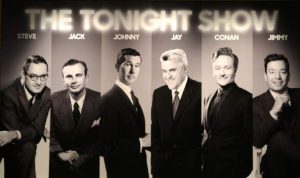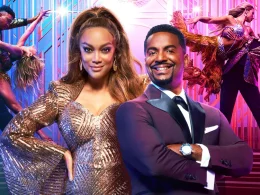Introduction
Late-night television has been a staple of American culture for decades, evolving through various phases and adapting to the changing tastes and preferences of its audience. From the early days of variety shows to the current era of digital integration, late-night TV trends have consistently shaped and reshaped the landscape of entertainment. This article delves into the evolution of late-night TV, highlighting key trends and innovations that have defined this unique genre.
The Golden Age: The Birth of Late-Night TV

The history of late-night TV can be traced back to the 1950s when the genre first began to take shape. The pioneering show “Tonight Starring Steve Allen,” which premiered in 1954, set the stage for future late-night programs. Allen’s show combined comedy sketches, interviews, and musical performances, establishing a format that would become the blueprint for late-night TV.
Key Trends:
- Variety Format: Early late-night shows were characterized by a variety format that included monologues, comedy sketches, interviews, and musical performances.
- Celebrity Guests: The inclusion of celebrity guests became a hallmark of late-night TV, drawing viewers eager to see their favorite stars in a more relaxed setting.
- Live Audience: The presence of a live audience added an element of spontaneity and energy to the shows, making them more engaging for viewers.
The Carson Era: The Rise of the Talk Show

The 1960s and 1970s saw the emergence of Johnny Carson as the king of late-night TV. “The Tonight Show Starring Johnny Carson” became a cultural phenomenon, dominating the late-night landscape for three decades. Carson’s wit, charm, and ability to connect with both guests and audiences set a new standard for the genre.
Key Trends:
- Monologue Mastery: Carson’s opening monologues became legendary, setting the tone for the rest of the show and becoming a staple of late-night TV.
- Signature Segments: Carson introduced recurring segments like “Carnac the Magnificent” and “Stump the Band,” which added variety and kept viewers coming back for more.
- Influence on Future Hosts: Carson’s success inspired a new generation of late-night hosts, including David Letterman and Jay Leno, who would go on to shape the genre in their own right.
The Letterman-Leno Rivalry: The Battle for Late-Night Supremacy

The 1980s and 1990s witnessed a fierce rivalry between David Letterman and Jay Leno, both vying for the coveted late-night audience. Letterman’s “Late Night with David Letterman” on NBC and later “The Late Show with David Letterman” on CBS brought a more irreverent and unconventional approach to late-night TV, while Leno’s “The Tonight Show” maintained a more traditional format.
Key Trends:
- Edgy Humor: Letterman’s offbeat humor and willingness to push boundaries resonated with a younger audience, setting him apart from his competitors.
- Stunts and Gags: Letterman popularized the use of stunts and gags, such as “Stupid Pet Tricks” and “Top Ten Lists,” which became iconic elements of his show.
- Network Battles: The rivalry between Letterman and Leno highlighted the competitive nature of late-night TV, with networks investing heavily in their respective shows to capture the largest audience share.
The Digital Revolution: Late-Night TV in the Internet Age

The advent of the internet and social media in the 2000s brought significant changes to late-night TV. Shows began to embrace digital platforms, extending their reach beyond traditional broadcast audiences. Hosts like Jimmy Fallon, Stephen Colbert, and James Corden leveraged the power of viral content to engage with viewers in new and innovative ways.
Key Trends:
- Viral Videos: Late-night hosts started creating segments specifically designed to go viral, such as Jimmy Fallon’s “Lip Sync Battle” and James Corden’s “Carpool Karaoke.”
- Social Media Integration: Late-night shows embraced social media platforms like Twitter, Instagram, and YouTube to interact with fans and promote their content.
- Cross-Platform Content: Hosts began producing exclusive content for digital platforms, blurring the lines between traditional TV and online entertainment.
The Future of Late-Night TV: Trends and Innovations

As we look to the future, late-night TV continues to evolve, adapting to new technologies and audience preferences. Emerging trends and innovations are shaping the next generation of late-night entertainment.
Key Trends:
- Diverse Voices: There is a growing emphasis on diversity and inclusion, with more late-night shows featuring hosts and guests from diverse backgrounds.
- Interactive Content: Advances in technology are enabling more interactive and immersive experiences for viewers, such as live polls and audience participation.
- Streaming Services: The rise of streaming services is changing the distribution model for late-night TV, with some shows being produced exclusively for platforms like Netflix and Hulu.
Conclusion
The evolution of late-night TV is a testament to the genre’s ability to adapt and innovate in response to changing cultural and technological landscapes. From the early variety shows to the digital age, late-night TV trends have continually pushed the boundaries of entertainment, creating a dynamic and ever-evolving genre that continues to captivate audiences.
By understanding the key trends and innovations that have shaped late-night TV, we can appreciate the rich history and exciting future of this beloved form of entertainment. As late-night TV continues to evolve, it will undoubtedly remain a vital part of our cultural fabric, providing laughter, insight, and connection for generations to come.












